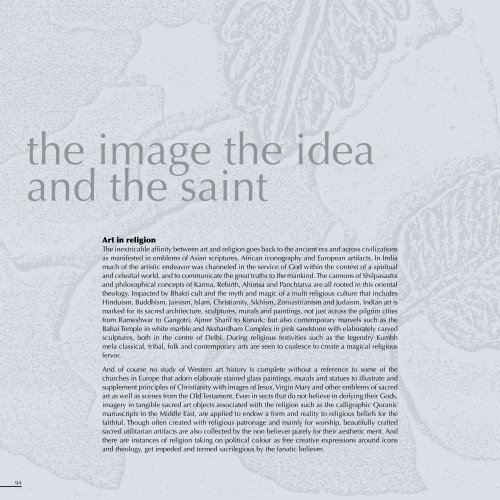download - Art Positive
download - Art Positive
download - Art Positive
Create successful ePaper yourself
Turn your PDF publications into a flip-book with our unique Google optimized e-Paper software.
the image the idea<br />
and the saint<br />
<strong>Art</strong> in religion<br />
The inextricable affinity between art and religion goes back to the ancient era and across civilizations<br />
as manifested in emblems of Asian scriptures, African iconography and European artifacts. In India<br />
much of the artistic endeavor was channeled in the service of God within the context of a spiritual<br />
and celestial world, and to communicate the great truths to the mankind. The cannons of Shilpasastra<br />
and philosophical concepts of Karma, Rebirth, Ahimsa and Panchtatva are all rooted in this oriental<br />
theology. Impacted by Bhakti cult and the myth and magic of a multi religious culture that includes<br />
Hinduism, Buddhism, Jainism, Islam, Christianity, Sikhism, Zoroastrianism and Judaism, Indian art is<br />
marked for its sacred architecture, sculptures, murals and paintings, not just across the pilgrim cities<br />
from Rameshwar to Gangotri, Ajmer Sharif to Konark; but also contemporary marvels such as the<br />
Bahai Temple in white marble and Akshardham Complex in pink sandstone with elaborately carved<br />
sculptures, both in the centre of Delhi. During religious festivities such as the legendry Kumbh<br />
mela classical, tribal, folk and contemporary arts are seen to coalesce to create a magical religious<br />
fervor.<br />
And of course no study of Western art history is complete without a reference to some of the<br />
churches in Europe that adorn elaborate stained glass paintings, murals and statues to illustrate and<br />
supplement principles of Christianity with images of Jesus, Virgin Mary and other emblems of sacred<br />
art as well as scenes from the Old Testament. Even in sects that do not believe in deifying their Gods,<br />
imagery in tangible sacred art objects associated with the religion such as the calligraphic Quranic<br />
manuscripts in the Middle East, are applied to endow a form and reality to religious beliefs for the<br />
faithful. Though often created with religious patronage and mainly for worship, beautifully crafted<br />
sacred utilitarian artifacts are also collected by the non believer purely for their aesthetic merit. And<br />
there are instances of religion taking on political colour as free creative expressions around icons<br />
and theology, get impeded and termed sacrilegious by the fanatic believer.<br />
94




